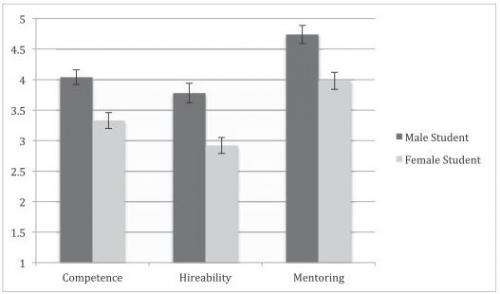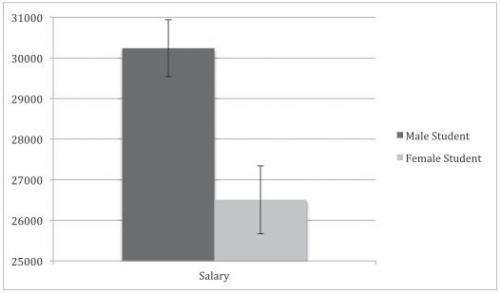September 21, 2012 report
Marie Curie, go home: Science faculty study shows bias

(Phys.org)—A study published in PNAS shows that science faculty members, both men and women, need to bring up their poor grades in gender bias. The study. "Science Faculty's Subtle Gender Biases Favor Male Students," reveals people with hiring power in academic corridors of the sciences may have notions about men versus women that have negative repercussions on academia's stated goals of recruiting more women in the sciences. Corinne A. Moss-Racusina, John F. Dovidio, Victoria L. Brescoll, Mark J. Grahama, and Jo Handelsman, study authors, represent cross disciplines from departments of cellular and development biology, psychology, management, and psychiatry, at Yale University.
The Yale team set out to experimentally investigate if science faculty members show a bias against students who are female. They designed a randomized double blind study of 127 subjects. They constructed a job-hiring scenario. Science faculty from research-intensive universities rated application materials of students, randomly assigned either male or female names, for a lab manager job.
Applications were all identical except for the male names and female names. Even though the male and female name applications were identical in competencies, the female student was less likely to be hired, being viewed as less competent and desirable as a new-hire.
Results further showed the faculty members chose higher starting salaries and more career mentoring for applicants with male names.

Interestingly, it made no difference on hiring decisions as to whether the faculty member was male or female. Bias was just as likely to occur at the hands of a female as well as male faculty member.
The study's results suggest gender bias is alive and detrimental to a field where talents and skills are so needed.
Dr. Susan Hockfield, a neuroscientist who previously served as the first woman to head MIT, once noted that squandered talent "is one of the key issues of women in science and engineering." At the time when she took office, there was a gender debate being sparked by then Harvard's president, Lawrence Summers, in 2005, that one reason for the relative shortage of women at the upper ranks of science might be because of an innate lesser ability.
According to reports of the event, where Summers was speaking at a conference, an MIT biologist, female, walked out of his talk, saying that if she had not walked out she would have either blacked out or thrown up. The recent PNAS (Proceedings of the National Academy of Sciences, published by the National Academy of Sciences) study suggests "intervention" addressing faculty gender bias, as the intervention may advance the goal of increasing women's participation in science.
More information: Science faculty's subtle gender biases favor male students, PNAS, Published online before print September 17, 2012, doi: 10.1073/pnas.1211286109
Abstract
Despite efforts to recruit and retain more women, a stark gender disparity persists within academic science. Abundant research has demonstrated gender bias in many demographic groups, but has yet to experimentally investigate whether science faculty exhibit a bias against female students that could contribute to the gender disparity in academic science. In a randomized double-blind study (n = 127), science faculty from research-intensive universities rated the application materials of a student—who was randomly assigned either a male or female name—for a laboratory manager position. Faculty participants rated the male applicant as significantly more competent and hireable than the (identical) female applicant. These participants also selected a higher starting salary and offered more career mentoring to the male applicant. The gender of the faculty participants did not affect responses, such that female and male faculty were equally likely to exhibit bias against the female student. Mediation analyses indicated that the female student was less likely to be hired because she was viewed as less competent. We also assessed faculty participants' preexisting subtle bias against women using a standard instrument and found that preexisting subtle bias against women played a moderating role, such that subtle bias against women was associated with less support for the female student, but was unrelated to reactions to the male student. These results suggest that interventions addressing faculty gender bias might advance the goal of increasing the participation of women in science.
Journal information: Proceedings of the National Academy of Sciences
© 2012 Phys.org














